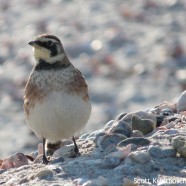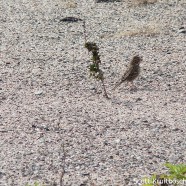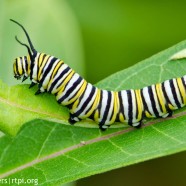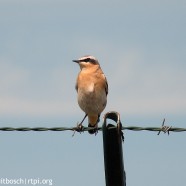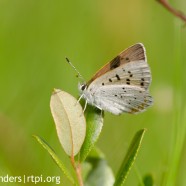Horned Lark (Eremophila alpestris)
The Horned Lark (Eremophila alpestris) is a species of open areas – the tundra, grasslands, fields, beaches and dunes and even the desert. Unsurprisingly they feed on the ground on insects and seeds and often take advantage of human activity disturbing areas such as mowed airports or piles of plowed earth or snow that expose more food. When it comes to the winter you will find them wherever it is the most bare. You can frequently spot them with Snow Buntings and, more rarely, the Lapland Longspur. They are also another species decreasing across much of their range and are listed as...
Read MoreVesper Sparrow (Pooecetes gramineus)
In the continuing spirit of “it’s time to find [bird X]”…it’s right about time to find the Vesper Sparrows! This large sparrow has a bright, bold white eye ring that stands out in nearly any conditions. It can find the perfect habitat for migration throughout the Chautauqua-Allegheny region favoring farms, grasslands, fields and even scrubby or rocky areas like this one. If you ever spot a Vesper Sparrow during nesting season please let us know so we can help you do all you can to protect the habitat. They are decreasing in many areas of their range including...
Read MoreMonarch caterpillar
Monarch butterfly caterpillars like this one have been seen in higher than typical numbers, compared to recent years, in some areas. However, others in the region have told me they have seen a total of zero. It seems to be a year of dissenting data. Even last week at a meeting of naturalists from across the Chautauqua-Allegheny region we had some people excitedly reporting improved Monarch numbers while others dolefully spoke of few or none. The butterflies continue to be seen here and there and you should keep an eye out for them during this migratory period. I will be surveying the shores...
Read MoreNorthern Wheatear season
The Northern Wheatear is undoubtedly one of my favorite North American nesting species despite the fact it is one of the toughest to find in the contiguous United States. I have no real reason for why I love the bird except for the fact that it is so difficult to call it simply a “North American” species and I admire its biology. Two populations nest on the continent with a western group breeding in Alaska and far northwest Canada with an eastern group in north central and northeastern Canada, the former group migrating southeastward across Asia to move to Europe and finally...
Read MoreBog Copper (Lycaena epixanthe)
National Pollinator Week continues! This Bog Copper (Lycaena epixanthe) is found only where its name suggests, acid bogs with cranberries, making it a relatively rare species.
Read More



